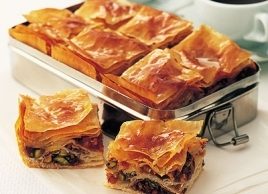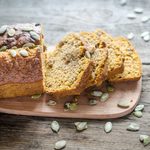Fruit and Pistachio Baklava
Here is an updated version of the traditional Greek pastry, made with a filling of dates, dried mango and pistachio nuts. Although this fruit and pistachio baklava uses less fat and honey than usual, it is most definitely a special sweet snack.
Source: Cook Smart for a Healthy Heart, Reader’s Digest Canada

| Servings | Prep Time | Cook Time |
| 20squares | 30minutes | 30minutes |
| Servings | Prep Time |
| 20squares | 30minutes |
| Cook Time |
| 30minutes |
- 2 tbsp reduced-salt margarine
- 2 tbsp sunflower oil
- 80 g dried mango finely chopped
- 1/2 cup dried pitted dates finely chopped
- 1/2 cup pistachios finely chopped
- 1 1/2 tsp ground cinnamon
- 20 sheets filo pastry about 18 x 30 cm each
- 2/3 cup clear honey
- 1/4 cup freshly squeezed orange juice
|
Ingredients
Servings: squares
Units:
|
- Gently heat the margarine and oil in a small saucepan until melted and blended. Remove the pan from the heat and set aside. Mix together the dried mango, dates, pistachios and cinnamon in a bowl. Set aside.
- Preheat the oven to 425ºF (220ºC). Lightly grease a shallow 28 x 18 cm (11 x 7 in.) pan with some melted margarine mixture.
- Place 1 sheet filo pastry in the bottom of the pan, allowing the pastry to come up the sides if necessary, and brush sparingly with the melted margarine. Layer over 4 more sheets of filo, brushing each one lightly with the melted margarine. Spread with one-third of the fruit mixture and half the honey.
- Repeat the layering of filo sheets and fruit mixture twice. Top with the remaining 5 sheets of filo, brushing each sheet with melted margarine. Trim the edges of the pastry to fit the pan.
- Mark the surface of the pastry into 20 squares using a sharp knife. Bake for 15 minutes, then reduce the oven to 350ºF (180ºC). Bake 10–15 minutes or until crisp and golden-brown.
- Meanwhile, gently warm the remaining honey and orange juice in a small saucepan until blended, stirring constantly.
- Remove the cake pan from the oven and pour the honey and orange mixture evenly over the cooked fruit and pistachio baklava. Leave it to cool in the pan. When cold, cut into the marked squares for serving.
Per serving: 158 calories, 2 g protein, 6 g total fat, 1 g saturated fat, 0 mg cholesterol, 24 g total carbohydrate, 16 g sugars, 1 g fibre, 115 mg sodium
The nutrients in fresh fruit are concentrated when they are dried, so they are much higher in minerals, dietary fibre and some vitamins such as beta carotene. Most of their vitamin C, however, is lost after drying but they nevertheless remain nutritious cooking ingredients.




